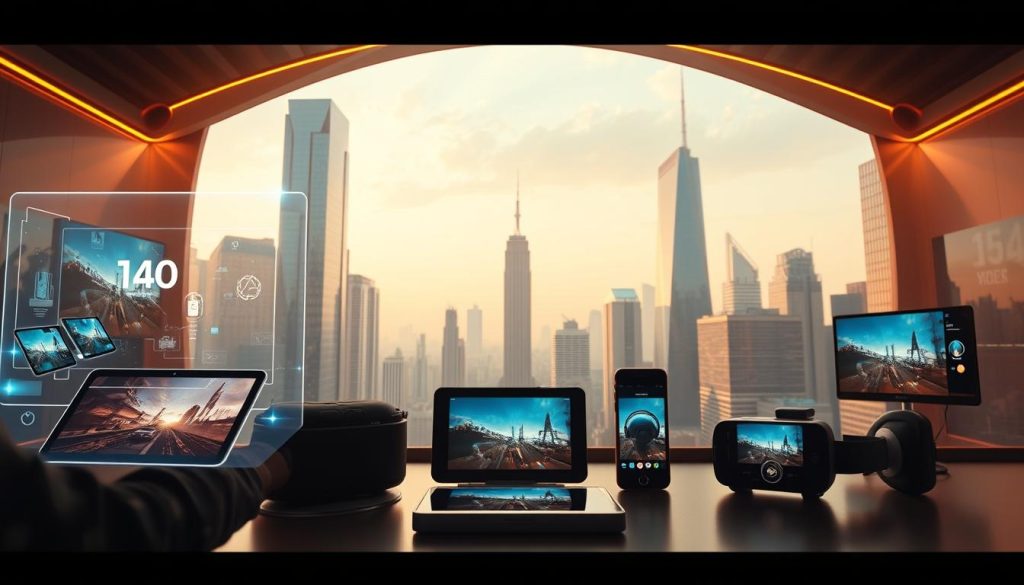Are you ready to unlock the secrets of the ever-evolving digital landscape?
As we approach 2025, the world of digital media is on the cusp of a revolution. With technological advancements happening at a breakneck pace, staying ahead of the curve is crucial for businesses and individuals alike.
This article will explore the top trends shaping the future of digital media, providing insights into the latest developments and their implications for the industry.
Key Takeaways
Table of Contents
- Understanding the impact of emerging technologies on digital media
- Identifying the key trends that will shape the industry in 2025
- Gaining insights into the future of digital marketing and its outlook
- Learning how to stay ahead of the curve in the ever-evolving digital landscape
- Discovering the opportunities and challenges presented by the latest digital media trends
The State of Digital Media Trends 2025
In 2025, the digital media industry is experiencing a seismic shift, driven by advancements in AI, VR, and other emerging digital technologies. The way content is created, distributed, and consumed is changing rapidly, with AI in digital media playing a crucial role in this transformation. Online content trends are shifting towards more personalized and interactive experiences, driven by the need for businesses to engage their audiences more effectively.
Key Factors Reshaping the Digital Landscape
The digital landscape is being reshaped by several key factors, including the increasing use of AI in digital media, the rise of virtual and augmented reality, and the growing importance of personalized content. These emerging digital technologies are not only changing the way businesses operate but also how they interact with their audiences.
Why These Trends Matter for Your Business
Understanding these online content trends and emerging digital technologies is crucial for businesses to stay competitive in 2025. By leveraging AI in digital media and other cutting-edge technologies, businesses can create more engaging and personalized experiences for their audiences, ultimately driving growth and revenue.
How to Implement AI-Powered Content Creation Strategies
Leveraging AI for content creation can significantly boost your digital marketing efforts. By integrating AI-powered tools into your content strategy, you can enhance efficiency, personalize content, and improve engagement.
Setting Up Automated Content Generation Systems
To set up an automated content generation system, you need to choose the right AI tools that align with your content goals. AI-powered content creation involves using algorithms to generate content based on data inputs.
Tools and Platforms for Different Content Types
Different content types require different tools. For instance, blog posts can be generated using platforms like WordLift, while social media content can be created with tools like Lately.
Balancing AI and Human Creativity
While AI can generate content efficiently, it’s crucial to balance AI-driven content with human creativity to ensure it resonates with your audience. As
“The best AI systems are those that augment human capabilities, not replace them.”
This balance is key to creating engaging and personalized content.
Measuring ROI from AI Content Investments
To measure the ROI from AI content investments, track metrics such as engagement rates, conversion rates, and content production costs. Here’s a sample table to illustrate how to track ROI:
| Metric | Before AI | After AI |
|---|---|---|
| Engagement Rate | 2% | 5% |
| Conversion Rate | 1.5% | 3% |
| Content Production Cost | $1000 | $500 |
Steps to Build Your Brand in the Metaverse and Virtual Reality
With the rapid advancements in virtual reality, brands now have the opportunity to create immersive experiences that captivate their audiences like never before. The metaverse, a collective virtual shared space, is becoming a critical platform for brand engagement.
Creating Immersive VR Experiences for Your Audience
To effectively build your brand in the metaverse, you need to focus on creating immersive VR experiences. This involves understanding your audience’s preferences and behaviors in virtual environments.
Entry-Level VR Strategies for Small Businesses
For small businesses, starting with simple VR experiences can be a cost-effective way to enter the metaverse. Consider the following strategies:
- Develop a virtual storefront that allows customers to explore products in 3D.
- Create interactive tutorials or product demos.
- Host virtual events or workshops.
Advanced VR Applications for Enterprise
For larger enterprises, the possibilities are vast. Advanced VR applications can include:
- Complex training simulations for employees.
- Immersive brand storytelling experiences.
- Virtual reality advertising campaigns.
Measuring Success in Virtual Environments
To measure the success of your VR initiatives, focus on metrics such as engagement time, user interaction rates, and conversion rates. These metrics will help you understand how your audience is responding to your VR experiences and where improvements can be made.
By leveraging these strategies and metrics, brands can effectively build their presence in the metaverse and virtual reality, staying ahead of emerging digital technologies and capitalizing on online content trends.
How to Master Emerging Social Media Innovations
The rapidly evolving world of social media demands a keen eye on innovations that can elevate your brand’s online presence. As we navigate through 2025, it’s crucial to stay ahead of the curve by adopting strategies that align with the latest digital media trends.
Platform-Specific Strategy Development
Developing a platform-specific strategy is vital for maximizing your brand’s reach and engagement on social media. Different platforms cater to different audience behaviors and preferences, making it essential to tailor your content and approach accordingly.
TikTok and Short-Form Video Optimization
TikTok continues to dominate the social media landscape with its short-form video content. To optimize your presence on TikTok, focus on creating engaging, high-quality videos that resonate with your target audience. Utilize trending challenges and hashtags to increase your visibility.
Leveraging New Social Commerce Features
Social commerce is on the rise, with platforms introducing new features that enable seamless shopping experiences. Leverage these features by integrating your product catalogs and utilizing in-app checkout options to streamline the customer journey.

Building Community Through Interactive Features
Building a strong community around your brand is key to long-term success on social media. Interactive features such as polls, quizzes, and live streams can significantly enhance engagement and foster a sense of belonging among your followers.
“The future of social media is not just about broadcasting your message, it’s about creating a two-way conversation that builds trust and loyalty with your audience,” said a leading social media expert. By focusing on interactive content, you can create a more immersive experience that drives meaningful interactions.
Guide to Creating Personalized Digital Experiences
The digital marketing outlook for 2025 indicates a significant shift towards personalized digital experiences. As emerging digital technologies continue to evolve, businesses are now able to create highly tailored interactions with their audiences, enhancing user engagement and driving conversions.
Implementing Data-Driven Personalization
Data-driven personalization is at the heart of creating meaningful digital experiences. By leveraging user data, businesses can craft content and offers that resonate with individual preferences and behaviors.
Ethical Data Collection Methods
It’s crucial to implement ethical data collection methods to build trust with your audience. Transparency about data usage and ensuring compliance with privacy regulations are key to maintaining a positive brand image.
Segmentation and Targeting Techniques
Effective segmentation and targeting techniques allow businesses to deliver content that is relevant to specific audience segments. By analyzing user behavior and preferences, brands can create targeted campaigns that drive engagement.
Developing Dynamic Content That Adapts to User Behavior
Creating dynamic content that adapts to user behavior is essential for maintaining user interest. By using AI-powered content generation tools, businesses can develop content that evolves based on user interactions, ensuring a consistently engaging experience.
As we look to the future of digital media, it’s clear that personalization will play a pivotal role in shaping successful digital strategies. By focusing on data-driven personalization and dynamic content, businesses can stay ahead of the curve and meet the evolving expectations of their audiences.
How to Capitalize on Video Streaming and Audio Content Trends
The digital media landscape is evolving rapidly, with video streaming and audio content emerging as key players in 2025. As consumers increasingly turn to online platforms for entertainment, businesses must adapt to these video streaming developments to stay relevant.

Developing Interactive Streaming Content
To capitalize on the growing demand for video streaming, creators should focus on developing interactive streaming content. This can include live streams with real-time engagement, such as Q&A sessions or polls, which enhance viewer participation.
Live Streaming Best Practices
For successful live streaming, consider the following best practices:
- Promote your live stream across social media channels.
- Ensure high-quality audio and video.
- Engage with your audience in real-time.
Monetization Strategies for Creators
Creators can monetize their streaming content through various strategies, including:
| Monetization Method | Description | Potential Revenue |
|---|---|---|
| Subscriptions | Offer exclusive content for loyal viewers. | $5-$20/month |
| Ad Revenue | Integrate ads into your streaming content. | $2-$10 per 1,000 views |
| Sponsorships | Partner with brands for sponsored content. | $100-$1,000 per stream |
Optimizing Podcast and Audio Content for Growth
In addition to video streaming, audio content, such as podcasts, continues to grow in popularity. To optimize podcast content, focus on high-quality production and consistent release schedules. Leveraging AI in digital media can also help in analyzing listener data to create more targeted content.
By understanding online content trends and adapting your strategy accordingly, you can ensure continued growth and engagement with your audience.
Conclusion: Future-Proofing Your Digital Media Strategy
As we look ahead to 2025, it’s clear that the digital media landscape will continue to evolve at a rapid pace. Staying ahead of the curve requires a deep understanding of the latest digital media trends 2025, including the rise of AI-powered content creation, immersive experiences in the metaverse, and personalized digital interactions.
To future-proof your digital media strategy, it’s essential to be adaptable and innovative. By leveraging the insights and trends discussed in this article, you can position your brand for success in the ever-changing digital landscape. The future of digital media is bright, with new opportunities emerging in video streaming, audio content, and social media innovations.
A forward-thinking digital marketing outlook will enable you to capitalize on these trends and drive growth. By embracing the latest technologies and strategies, you can create engaging, personalized experiences that resonate with your audience and set your brand apart from the competition.
FAQ
What are the key digital media trends to watch in 2025?
The key digital media trends to watch in 2025 include the rise of AI-powered content creation, the growth of virtual reality and the metaverse, emerging social media innovations, and the increasing importance of personalized digital experiences.
How can businesses implement AI-powered content creation strategies?
Businesses can implement AI-powered content creation strategies by setting up automated content generation systems, leveraging tools and platforms for different content types, and balancing AI-driven content with human creativity.
What are the benefits of creating immersive VR experiences for my brand?
Creating immersive VR experiences can help your brand stand out, increase customer engagement, and provide a unique and memorable experience for your audience.
How can I measure the success of my VR marketing efforts?
To measure the success of your VR marketing efforts, you can track metrics such as user engagement, time spent in VR environments, and conversion rates.
What are the latest social media innovations that I should be aware of?
The latest social media innovations include the rise of short-form video content, new social commerce features, and interactive features that enable community building and engagement.
How can I create personalized digital experiences for my audience?
To create personalized digital experiences, you can implement data-driven personalization, use ethical data collection methods, and develop dynamic content that adapts to user behavior.
What are the best practices for live streaming and monetizing video content?
Best practices for live streaming include optimizing your stream for different platforms, engaging with your audience, and using high-quality equipment. To monetize your video content, you can use strategies such as sponsorships, advertising, and subscription-based models.
How can I optimize my podcast and audio content for growth?
To optimize your podcast and audio content for growth, you can focus on creating high-quality content, using effective distribution channels, and promoting your content through social media and other marketing channels.


